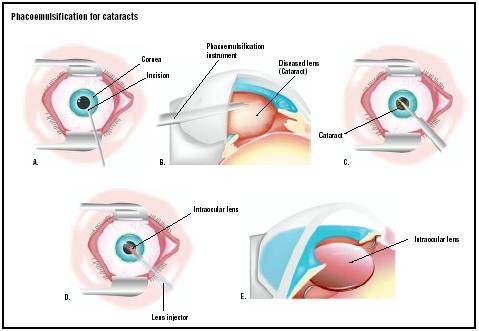
Phacoemulsification is a surgical procedure used to correct cataracts. During the procedure, an ultrasonic probe is used to break down or emulsify the built up protein of the eye lens that causes cataracts. Once the proteins are broken up, and the lens fragments are removed, an artificial lens is inserted as a replacement. An intraocular lens (IOL), which is a new and clear lens, takes the place of the old lens, and the patient’s vision improves.
What is it?
A Cataract is an eye condition that occurs when the eye lens clouds and causes vision loss. Cataracts usually occur in the elderly or after one experiences trauma to the eye. To treat cataracts, the cloudy eye lens must be replaced with a clear, artificial lens. Phaco and IOL is a surgical procedure that works in two parts. First, it removes the cloudy lens by emulsifying it using an ultrasonic probe. This involves making small incisions in the eye to allow the surgeon to insert the ultrasonic probe so that it may directly emulsify the cataract. Then, after the original eye lens is suctioned out, the intraocular lens (IOL) is inserted in its place.
What should I do to prepare?
In preparation for phacoemulsification and intraocular lens transplantation, it is important that patients stop using blood thinning medications at least two weeks before the surgery. They should talk with their doctors to determine if they should cease using other medications or supplements. It is also recommended that patients start using eyedrops weeks before the surgery. The night before the surgery, the patient should not eat or drink anything.
What happens during the process?
During the procedure, patients will receive a local anesthetic or topical anesthetic to manage pain and stop eye movement. The surgeon will insert the ultrasonic probe and remove the aspirated lens after making a small incision in the white of the eye. Afterward, the IOL is inserted through the same small incision in a folded or rolled up form. The surgeon ensures that the new lens is put in its proper place. No stitches are required for the incision in the eye as it will heal on its own. In all, the procedure should only take between 15 minutes to an hour.
What are the risks and potential complications?
Risks involved with this procedure are unlikely but still possible. These risks include spontaneous bleeding from the wound, flashing, floaters, double vision, infections of the eyeball, retinal detachment, onset of glaucoma, blindness, and secondary cataracts. Infections of the eyeball may occur, but are rare since antibiotic eye drops are usually used post-surgery. Retinal detachment is a serious but rare side effect. Seeing floaters or experiencing abnormal changes in vision may be a sign that the retina detached during the surgery due to prior retinal weakness. This side effect may not be experienced for weeks to months. In the event of a secondary cataract forming on the remainder of the lens, a non-surgical laser procedure can be performed to remove it.
Disclaimer:
All GlobeHealer Site content, including graphics, images, logos, and text, among other materials on the site are for educational purposes only. This content is not intended to be a substitute for professional medical advice, and you should always contact your physician or qualified health provider for information regarding your health. Information on this site regarding the overview, diagnosis, and treatment of any kind should be looked at, in addition to the advice and information of your health care professional. Do not disregard medical advice or delay seeking treatment or medical advice due to information found on the GlobeHealer site.
If there is even the possibility that you may have a medical emergency, seek treatment, call your doctor, or call your local emergency telephone number immediately. GlobeHealer does not endorse being the first line of communication in case of emergency and does not endorse any specific test, physician, facility, product, procedure, opinion, or other information that is or may be mentioned on this site or affiliated entities. Reliance of any and all information provided by GlobeHealer, its employees, affiliations, others appearing on the Site under the invitation of GlobeHealer, or visitors of the site is solely at your own risk and is not the responsibility of GlobeHealer.
Image Source: http://www.surgeryencyclopedia.com/Pa-St/Phacoemulsification-for-Cataracts.html
